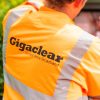GigaTAG List Solutions to Boost UK Gigabit Broadband Take-up UPDATE

The new Gigabit Take-Up Advisory Group (GigaTAG), which is led by paid consumer magazine Which? and various others (FSB, CBI, Ofcom etc.), has today published their first report that identifies a number of areas where improvements could be made to boost the take-up of 1Gbps capable broadband services in the UK.
At present the Government’s £5bn Gigabit Broadband Programme, which has initially only released £1.2bn of this funding, is targeting a minimum of 85% “gigabit-capable” UK network coverage by the end of 2025, but will seek to accelerate that roll-out further to get “as close to 100% as possible.” The private sector is largely expected to reach around 70%+ via commercial projects, while the Government’s investment will thus focus on around 5-6 million premises in the final 20% of the UK (i.e. the hardest to reach areas).
Hopefully it still goes without saying that network availability is the key barrier to adoption of any new internet access solution, but we know that already. As such today’s report is more concerned with what happens once that service has actually become available.
Advertisement
We know from our own experience in this market that a number of factors can impact take-up, such as the higher prices for gigabit-capable services, as well as a lack of general awareness (i.e. locals don’t always know that the faster service exists) or interest in the new connectivity (e.g. if you have a decent ADSL2+ speed and only basic needs then you might feel less inclined to upgrade).
The fear of switching to a different ISP may also obstruct some services and so can long contract terms with existing packages (customers can’t switch immediately). On top of that we’ve long complained about the difficulty of accessing coverage data to build our own multi-network availability checker, with major operators like Openreach and Virgin Media being resistant or putting too many obstacles in the way (an agreed and accessible industry standard would be welcome).
In other cases, gigabit services may be available but consumers might choose not to sign-up due to a dislike of the provider offering the service (i.e. once bitten, twice shy) or the fact that there may not be enough service choice from the only available ISP (e.g. lack of static IP addresses, use of CGNAT or being forced to use a poor quality router/modem device). A good level of flexible wholesale access for other ISPs can often resolve some of this.
Rocio Concha, Which?’s Chair of GigaTAG, said:
“This year has highlighted the importance of quality broadband connections, but our research has identified significant hurdles that could undermine plans to ensure consumers and businesses have access to faster and more reliable services for years to come.
As we finalise our recommendations for increasing demand among consumers and businesses, it is clear that an ambitious and joined-up effort is needed across industry, government, consumer groups, businesses and the regulator to ensure the UK becomes a leader in digital connectivity.”
The new GigaTAG Report recognises a lot of the aforementioned factors and proposes some familiar solutions, such as the need for clear and consistent terminology (i.e. the often highlighted abuse of “fibre broadband” terminology by non FTTP services seems likely to come up again), improved availability checkers and a labelling system for broadband packages. These are just some of their initial recommendations.
Advertisement
GigaTAG’s Desired Outcomes
— Developing clear and consistent terminology and practical use-cases for gigabit-capable broadband, as well as information campaigns, to help improve awareness.
— A labelling system for broadband packages to provide simple, clear and consistent information.
— An employer-led scheme similar to the Cycle to Work scheme to support firms in encouraging employees to take up gigabit-capable broadband.
— An availability tool for consumers and businesses to check if gigabit broadband is available in their area.
At the same time we shouldn’t forget that take-up of any new service is something that will almost always grow organically over time. Only on very rare occasions do we see 100% of people in a given area sign-up to a new service immediately and it often takes several years for this to mature (growing most rapidly during the first 1-3 years). A quick look at the take-up of “superfast broadband” (30Mbps+) capable lines helps to highlight this.

The full table of GigaTAG’s desired outcomes can be found below. The group said they were keen to hear stakeholders’ thoughts on this document by 5th February 2021. In particular, it is keen to understand whether these are the right barriers (for the most part, we’d say they are) and if the emerging solutions are focused in the right areas.
We should point out that some of the barriers the group has identified are already being addressed through Ofcom’s current work programme (e.g. improved switching between networks, plus end-of-contract and annual best tariff notifications), which have thus been removed from the table below.
Advertisement

UPDATE 11:02am
The first reactions are coming in.
Daniel Butler, Hyperoptic’s Director of Communications and Policy, said:
“As the first provider to provide residential gigabit broadband services, we have enthusiastically engaged with the Gigabit Take-up Advisory Group to share our industry experience. Over the last nine years of delivering gigabit-enabled services, we have learned that once customers experience the difference of a full-fibre connection, they don’t ever want to downgrade back to a part fibre service. Since our inception, we have had strong demand when and wherever we offer our gold standard of service, which is testament to UK’s on-going and increasing need for hyperfast and reliable connectivity.
We are pleased that the GigaTag Interim Report has correctly identified many of the barriers to fibre take-up and that driving take-up requires an active role from Government, Ofcom and local authorities. We welcome the areas of priority outlined – particularly, providing clear information to consumers via a labelling scheme, removing process barriers via streamlined switching and installation processes, and removing cost barriers via vouchers and other incentives. We will continue to offer our insight to help shape these proposals.”
Alistair Cromwell, Acting CEO of Citizens Advice, said:
“Since the March lockdown began, internet access has been vital to home working, running small businesses, accessing essential services like healthcare, and continuing education. It’s crucial that those who are struggling financially aren’t locked out.
We welcome Ofcom’s call for broadband providers to offer targeted affordable tariffs for customers on low incomes. But we can’t afford to wait for providers to take what may be piecemeal and inconsistent steps. There is an opportunity for government intervention.
Next week the government will bring the new European telecoms code into UK law. This is a unique chance for the department for Digital, Culture, Media and Sport (DCMS) to consider bold steps on broadband affordability. DCMS should use this opportunity to explore introducing mandatory affordable tariffs that broadband providers offer customers on lower incomes.”
Shan Eisenberg, COO of Netgem TV, said:
“Currently, consumers do not take up such products because understanding how they fit into their everyday life is still low. They may also be nervous of brands they don’t recognise, or just decide to struggle on with their current connection because they think the grass isn’t always greener.
Fibre connections should be marketed less around pure speeds they deliver but used to promote the wider services around them. This includes the services that consumers have grown accustomed to, such as Pay-TV bundles, as well as levelling these up for a gigabit connection to allow 4K streaming, and whole home WIFI when more and more of us are working from a spare room far away from the router.
If altnets don’t embrace these services, we will soon see a chasm open up between the number of customers and fibre connections available presenting a real challenge to long-term profitability.”
Greg Mesch, CEO of CityFibre, said:
“With nearly 20% of the UK now able to access Full Fibre and the rollout of this world-class digital infrastructure still gathering pace, it is everyone’s interest to ensure Britain’s consumers and business can now get connected.
We welcome GigaTAG’s report, confirming that significant barriers to take up do exist, and outlining some potential solutions, such as a new labelling system, to help overcome them. We look forward to working GigaTAG and other stakeholders to make these ideas a reality so we can unlock Full Fibre’s true potential.”
UPDATE 4pm
Andrew Glover, ISPA Chair, said:
“ISPA was pleased to be a member of the GigaTAG group. This interim report is an important first step towards encouraging take-up of gigabit capable networks and services by businesses and consumers. Gigabit-capable networks already cover approximately 1/3 of the UK and our members are ramping up their rollout plans to reach the rest of the country.
The interim report shows that getting consumers and businesses to actually take up these connections will be a real challenge, partially because people are generally happy with their current service or because they need more information to fully understand the benefits of gigabit broadband. Our members already invest a lot of time and resource into boosting take-up but the report shows that this is a challenge that needs to tackled collectively with local and national Government, as well as consumer and business organisations.”
Mark is a professional technology writer, IT consultant and computer engineer from Dorset (England), he also founded ISPreview in 1999 and enjoys analysing the latest telecoms and broadband developments. Find me on X (Twitter), Mastodon, Facebook, BlueSky, Threads.net and Linkedin.
« Openreach Hire 5,300 Extra UK Fibre Engineers and Go Full EV





















































Most people buy the lowest cost option that meets their needs.
I think part of the reason there is low adoption is that it gets deployed to areas with G.Fast or fast VDSL. People are watching their Netflix or whatever without any issue. Why would you upgrade if it’s meeting your needs.
I would imagine if they targeted areas with low broadband speed, they would see a faster adoption rate.
I struggle to get 20MBps down, I would jump on FTTP/H if it was here. I can see it’s deployed half a mile either side of me, where it’s already got decent VDSL but where I am nothing, and we are on a slow line.
Mark, you make a good point and you are mostly right. However, I am in G.Fast area and I can’t get G.Fast. G.Fast requires that you are within certain distance (I think at most 300 Meter) and that causes my neighbor who is 50 meter down the road to be able to order it yet I am not able to.
G.Fast is for very limited number of households. You are right in terms of if you can watch Netflix without interruption people in general won’t bother about higher speed.
I think what will help adoption is few key components.
– Large families
– Adaptation of UHD or 8K tv and streaming services
– Consoles
– Working from home.
All of the above will lead to more demand for bandwidth. I was actually looking to get FTTP installed yet the costing was the main issue. I got a quote of £8000 including VAT. Just felt it was to much money.